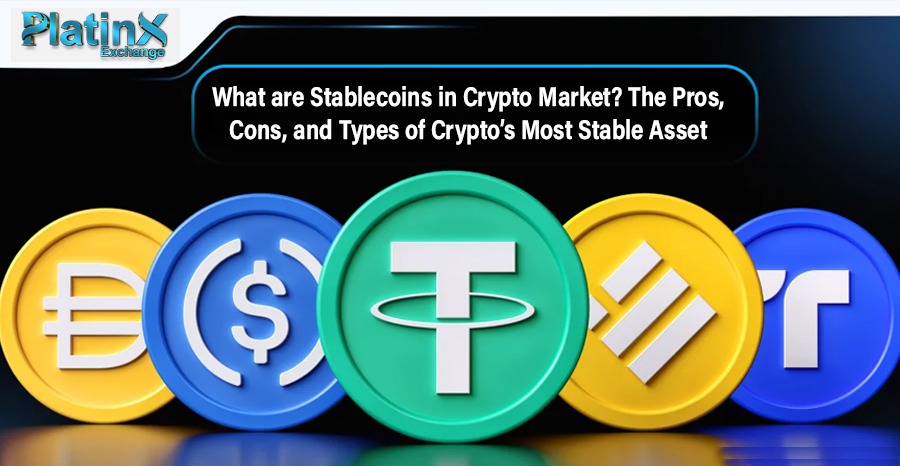Cryptocurrencies are digital assets that use cryptography to secure transactions and control the creation of new units. They are decentralized, meaning that they are not issued or regulated by any central authority. However, cryptocurrencies also have some drawbacks, such as high volatility, scalability issues, and regulatory uncertainty. This is where stablecoins come in.
Stablecoins in the crypto Market are a type of cryptocurrency that aims to maintain a stable value over time, pegged to the value of an underlying asset, such as a fiat currency, a commodity, or a financial instrument. They are designed to offer the benefits of crypto, such as fast, cheap, and secure transactions while avoiding the drawbacks of volatility and unpredictability. Stablecoins can be used as a medium of exchange, a store of value, and a unit of account in the crypto market and beyond.
The Pros of Stablecoins In Crypto Market
Stablecoins have several advantages over traditional cryptocurrencies and fiat currencies. Some of the pros of stablecoins are:
- Stability: Stablecoins reduce the risk of price fluctuations and market crashes, which can affect the value of cryptocurrencies and fiat currencies. By pegging their value to a more stable asset, stablecoins can preserve their purchasing power and protect users from losses.
- Liquidity: Stablecoins can enhance the liquidity of the crypto market, as they can facilitate the exchange of different cryptocurrencies and fiat currencies. Stablecoins can also bridge crypto and traditional financial systems, allowing users to access both markets easily and efficiently.
- Transparency: Stablecoins can leverage the transparency and immutability of blockchain technology, which can increase the trust and security of transactions. Stablecoins can also provide auditable and verifiable records of their reserves and operations, which can prevent fraud and manipulation.
- Innovation: Stablecoins can foster innovation and experimentation in the crypto space, as they can enable new use cases and applications that require stable and reliable value. Stablecoins can also support the development of decentralized finance (DeFi), which is a movement that aims to create open, permissionless, and interoperable financial services on the blockchain.
The Cons of Stablecoins In Crypto Market
Stablecoins are not without challenges and limitations. Some of the cons of stablecoins in the crypto market are:
- Complexity: Stablecoins can be complex and difficult to understand, as they involve various mechanisms and protocols to maintain their peg and stability. Stablecoins can also face technical issues and glitches, which can compromise their functionality and security.
- Trade-offs: Stablecoins can involve trade-offs between different aspects, such as decentralization, scalability, and governance. For example, some stablecoins may sacrifice decentralization and rely on centralized entities or intermediaries to manage their reserves and operations, which can expose them to censorship and regulation. Other stablecoins may sacrifice scalability and rely on complex algorithms or smart contracts to regulate their supply and demand, which can affect their performance and efficiency.
- Risks: Stablecoins can face various risks, such as market, regulatory, and operational risks. For example, some stablecoins may lose their peg and stability due to market shocks, arbitrage opportunities, or black swan events, which can cause their value to deviate from their target. Other stablecoins may face regulatory scrutiny and pressure, as they may pose threats to the monetary sovereignty and financial stability of governments and central banks. Moreover, some stablecoins may suffer from operational failures or attacks, such as hacking, theft, or fraud, affecting their security and reliability.
The Types of Stablecoins In The Crypto Market
Stablecoins can be classified into three main types, based on the mechanism they use to stabilize their value. These are:
- Fiat-collateralized stablecoins: These are stablecoins backed by fiat currencies, such as the U.S. dollar, the euro, or the yen, at a fixed ratio. These stablecoins are issued and redeemed by a centralized entity or custodian, which holds the fiat reserves in a bank account or a vault. Fiat-collateralized stablecoins are the most common and popular type, as they are relatively straightforward. However, they also have some drawbacks, such as the need for trust and verification of the issuer and the custodian, the exposure to regulatory and legal risks, and the lack of decentralization and innovation.
- Crypto-collateralized stablecoins: These are stablecoins that are backed by other cryptocurrencies, such as Bitcoin, Ethereum, or Dai, at a variable ratio. These stablecoins are issued and redeemed by a decentralized protocol or platform, which holds the crypto reserves in a smart contract or a vault. Crypto-collateralized stablecoins are more decentralized and innovative than fiat-collateralized stablecoins, as they do not rely on any centralized entity or intermediary. However, they also have some drawbacks, such as the need for over-collateralization and liquidation mechanisms to maintain their peg and stability, the exposure to volatility and market risks, and the complexity and difficulty of their design and implementation.
- Algorithmic stablecoins: These are stablecoins that are not backed by any asset, but rather by an algorithm or a smart contract that adjusts their supply and demand according to the market conditions. These stablecoins are issued and redeemed by a decentralized protocol or platform, which uses various incentives and penalties to encourage users to buy or sell the stablecoins and keep their value close to their target. Algorithmic stablecoins are the most decentralized and experimental type of stablecoins, as they do not rely on any collateral or reserve. However, they also have some drawbacks, such as the uncertainty and unpredictability of their behavior and performance, the exposure to game-theoretic and economic risks, and the lack of adoption and liquidity.
Frequently Asked Questions about Stablecoins
1. What are stablecoins?
Stablecoins are cryptocurrencies designed to maintain a stable price, typically pegged to a real-world asset like USD, EUR, or gold. They offer the benefits of crypto (fast transactions, global reach) with less volatility.
2. Why are stablecoins important?
Stablecoins offer several benefits:
- Price stability: Great for everyday transactions, lending/borrowing, and long-term investments.
- Accessibility: Bridge the gap between crypto and traditional finance, attracting new investors.
- Efficiency: Cross-border transactions become faster and cheaper.
- Transparency: Most operate on blockchain, ensuring verifiable records.
- Are there different types of stablecoins?
3. Are there different types of stablecoins?
Yes, there are three main types:
- Fiat-collateralized: Pegged to real-world assets like USD (e.g., Tether, USDC).
- Crypto-collateralized: Backed by other cryptocurrencies (e.g., DAI).
- Algorithmic: Use smart contracts to adjust supply and maintain peg (e.g., TerraUSD).
4. Are stablecoins safe?
Stablecoin safety depends on its type and underlying assets. Fiat-collateralized coins are generally considered safer, while algorithmic ones have more complex risks. Always research the issuing company and its practices.
5. How can I buy and sell stablecoins?
You can buy and sell stablecoins on various cryptocurrency exchanges and platforms. Research reputable platforms with strong security and regulatory compliance.
6. How are stablecoins regulated?
Regulation surrounding stablecoins is still evolving and varies by country. Be aware of potential regulatory risks and uncertainties.
7. Can stablecoins replace traditional currencies?
It’s too early to say definitively. While they offer advantages, challenges like scalability and regulatory clarity must be addressed before widespread adoption occurs.
8. What are the potential risks of stablecoins?
- Centralization: Some stablecoins rely on centralized entities, raising concerns about manipulation.
- Technical risks: Blockchain technology is vulnerable to hacks and glitches.
- Limited use cases: Compared to other cryptocurrencies, stablecoins have fewer applications.
- Regulation: The evolving regulatory landscape creates uncertainty.
9. Where can I learn more about stablecoins?
- Cryptocurrency news websites and blogs.
- Official websites of stablecoin projects.
- Financial industry publications and reports.
- Educational resources from reputable cryptocurrency exchanges.
10. Is investing in stablecoins right for me?
Do your research, understand the risks involved, and align your investment with your financial goals and risk tolerance. Never invest more than you can afford to lose.
Remember, stablecoins are a complex and evolving technology. Always stay informed, invest responsibly, and don’t hesitate to seek professional advice if needed.
Conclusion
Stablecoins are a fascinating and promising innovation in the crypto market, as they offer a solution to the problem of volatility and unpredictability of cryptocurrencies. Stablecoins can provide various benefits, such as stability, liquidity, transparency, and innovation, while facing challenges and limitations, such as complexity, trade-offs, and risks. Stablecoins in the crypto market can also be categorized into three main types, based on the mechanism they use to stabilize their value: fiat-collateralized, crypto-collateralized, and algorithmic stablecoins. Each type of stablecoin has its advantages and disadvantages, as well as its use cases and applications. Stablecoins are still evolving and improving, as they seek to achieve the ultimate goal of creating a stable and reliable digital currency for the crypto market and beyond.

